The Wracks – Edibility, Identification, Distribution
Egg wrack – Ascophyllum nodosum
Bladder wrack – Fucus vesiculosis
Channel(led) wrack – Pelvetia canaliculata
Spiral wrack – Fucus spiralis
Serrated (or tooth) wrack – Fucus serratus
Also Wrack Syphon Weed – Polysiphonia lanosa, which can often be found growing on wracks.
The wracks make up most of the green-brown mat that lies in the high to mid tidal range, and as such, are most commonly encountered by the average coastal explorer. Although each has some interesting culinary uses, they are mostly responsible for the poor image of seaweed as a food source that pervades the UK. I don’t find them as gastronomically rewarding as the other species listed on my seaweed guide, but they are super-common so I note here basic ID characteristics and some of my favourite uses. It is important to harvest only the tender parts at optimal times of year.
All wracks, if harvested in good condition (tender, new growth) make good stock powder that adds body, flavour and an awful lot of nutrition to soups, stews, sauces etc. Fully dehydrate until crisp then grind to a fine powder in a spice grinder. If you aren’t taking your wracks straight from a dehydrator, its usually best to toast them lightly in the oven or in a dry frying pan until they are crisp – this will make grinding a lot easier.
Possibly the most exciting flavour to be found among the wracks is a diminutive but ubiquitous little brown seaweed called wrack syphon weed (polysiphonia lanosa). It isn’t a wrack at all, but plies its trade among them (usually tooth wrack). Wrack syphon weed (I call it mermaid’s pubes, though you will occasionally see it more politely listed as sea truffle) has delicious properties once you overcome it’s challenging texture. Dried and powdered it tastes like truffled curried cauliflower.
If eating doesn’t appeal, wracks are the seaweeds to put in a hot bath – they will cleanse and soften your skin. Or wait for them to be washed up and become friable, and put them on you garden – they make excellent compost.
Related pages:
Egg wrack – Ascophyllum nodosum
Very common. Look for the egg-shaped float bladders, developing within stems. Ignore the larger, tough older “eggs” in favour of the tender young ones, which make pleasing eating and pickle nicely.
Bladder wrack – Fucus vesiculosis
Recognisable by its forking, flattened blades with prominent midrib, and paired air-filled bladders. The young growth tips are quite tender and can be added to soups and stews or mixed raw through salads. Bladderwrack is very high in iodine, and useful in the treatment of thyroid disorders. Particularly good for the stock powder technique described above.
Channelled wrack – Pelvetia canaliculata
Smaller than the other wracks and hyper-abundant around the high tide line/splash zone. Look for tufts of brown branching fronds, each with a distinct channel. They turn more yellow as they mature, developing small, elongated bladders. Tender fronds and young tips can be added to stir-fries, and pickle well. Despite often being overlooked as one of the less tasty seaweeds, crofters I have spoken to on the Outer Hebrides hold it in high esteem.
Spiral wrack – Fucus spiralis
Superficially similar to bladderwrack but close observation reveals that its stems do not lie flat, but twist and spiral. Its warty bladders are not paired (though, often conjoined to make heart shapes) nor air-filled. They contain a gelatinous liquid which is part of the seaweed’s reproductive cycle. If you can put that from your mind, they make excellent eating – succulent and salty, like a marine olive that burst on the tongue with a pleasing pop! Drop them in the pan or add to salads like capers. I turn my dirty martinis into filthy-dirty martinis by floating a few on top. Add a dusting of dried, powdered pepper dulse to the lip of the glass to complete the effect…
Serrated (or tooth) wrack – Fucus serratus
Lacking bladders and distinctive by the toothed edges of its flattened fronds, serrated wrack is my favourite wrack to eat raw. Trim off the tender tips and use as a vegetable or add to salads, sandwiches etc. Great for pickling.
Related pages:


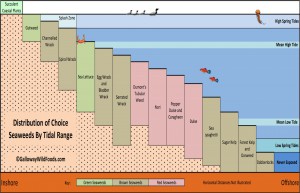
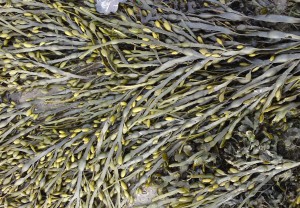

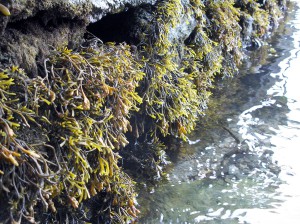
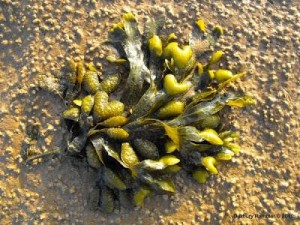
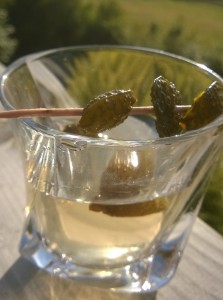
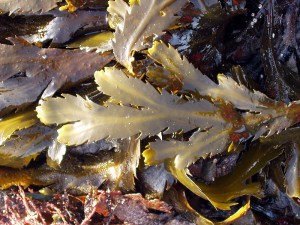
3 Comments
You have the most amazingly comprehensive site….i was just fishing along the rocks covered with bladderwrack….and started to research them…also pulled up some sea lettuce on my line. Looked them up, Maine bladderwrack, almost $30 a pound ($15 for live Lobster, lol) and sea lettuce $20 for eight ounces….I did not catch a fish, but i now will respect the seaweeds that i tread upon….you could kind of call it “Poor man’s Lobster”…..plus the health benefits within….Bladderwrack is 50% of one physicians supplement to fight leaky gut from plants high in Lectins and it is almost $80 for 120 capsules….i would say….quite the Gold Mine and i never plan to come back from fishing empty-handed again…THANKS!
Loved the “filthy” dirty martinis with spiral wrack and will definitely try it! thanks
Mark,
You have written very little about this but A.Nodosum is a hot topic mainly for fucoidan + other benefits even over the L.digitata, are you aware? Maybe you can find out and update us on this.
Can you explain if heat is used in cooking and enjoy algae then why during drying process it is taught to be in mild temperature?
Thanks.